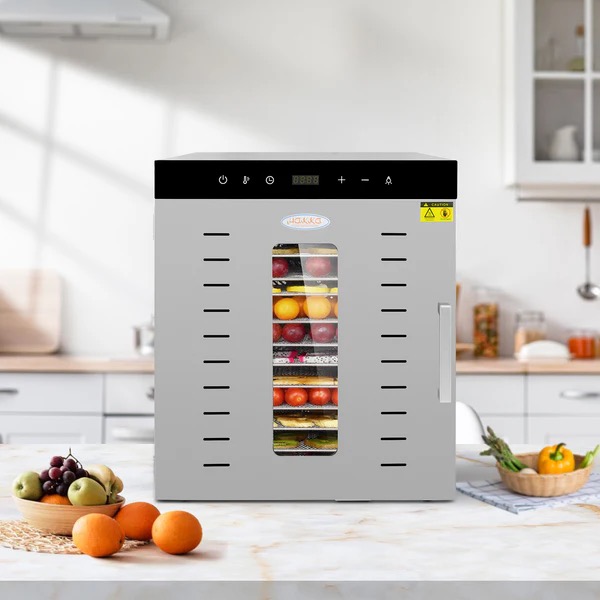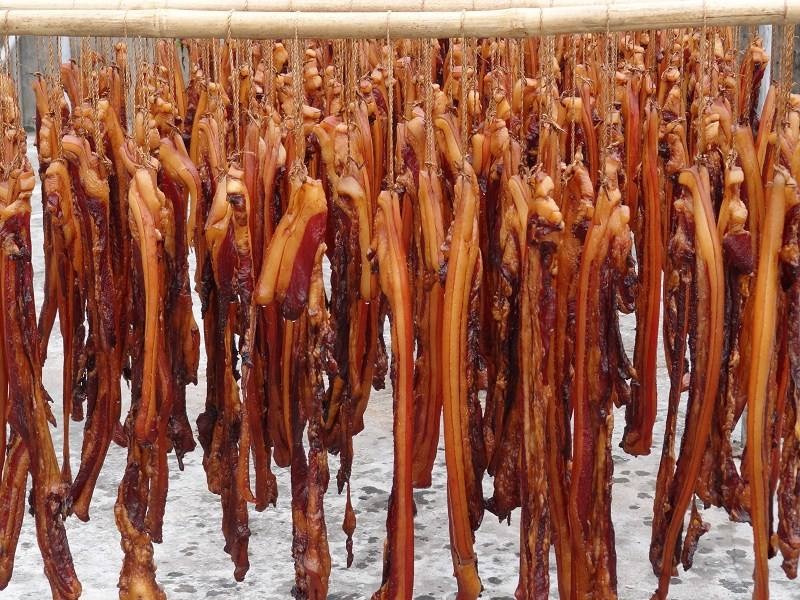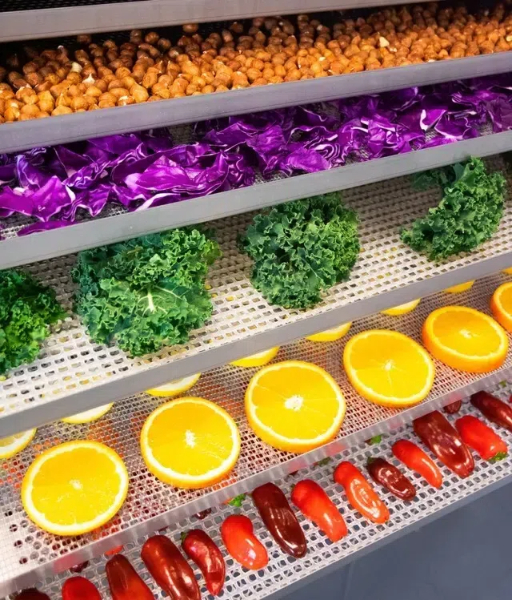
Content Menu
● Introduction
● Understanding Cabinet Type Dehydrators
● Benefits of Using Cabinet Type Dehydrators
● Versatile Applications in Food Processing
● Optimizing Drying for Various Food Types
● Best Practices for Using Cabinet Type Dehydrators Effectively
● The Future of Cabinet Type Dehydrators
● Conclusion
● FAQ
>> 1. What types of food can be dried in a cabinet dehydrator?
>> 2. How do I clean and maintain a cabinet dehydrator?
>> 3. What are the benefits of using a cabinet dehydrator over other drying methods?
>> 3. How energy-efficient are cabinet dehydrators?
>> 4. Can cabinet dehydrators be used for commercial purposes?
● Citations:
Introduction
In the dynamic world of food preservation and processing, the cabinet type dehydrator emerges as an indispensable tool, renowned for its versatility and unparalleled efficiency. As a leading Chinese food dehydrator manufacturing factory, we specialize in providing OEM services for discerning foreign food dehydrator brand owners, wholesalers, and manufacturers. Our meticulously engineered cabinet dehydrators are designed to cater to the diverse and evolving needs of the food industry, ensuring precise environmental control, superior energy efficiency, and consistently high-quality results. This comprehensive article delves into the wide-ranging applications of cabinet dehydrators in food processing, meticulously highlighting their myriad benefits, key features, and practical implementations across various sectors.

Understanding Cabinet Type Dehydrators
A cabinet type dehydrator is a sophisticated, self-contained unit specifically designed to meticulously remove moisture from food products within a strictly controlled environment. These advanced dehydrators seamlessly integrate a heat pump dryer with a precisely managed chamber, guaranteeing consistent and efficient drying outcomes. Unlike simpler dehydrators, cabinet models offer unmatched control, making them the preferred choice for both commercial applications and serious home users who demand the utmost in performance and reliability.
Key Components and Their Functions:
- Digital Control Systems: Modern cabinet dehydrators are equipped with state-of-the-art digital control systems, allowing for precise adjustment and real-time monitoring of critical parameters such as temperature, humidity, and airflow. These advanced systems ensure uniform drying throughout the chamber, which is paramount for maintaining the quality, texture, and consistency of dried products.
- Heating Elements: These essential components generate the warm air necessary for the dehydration process. High-efficiency heating systems and robust insulation are incorporated to minimize energy consumption, making the dehydrator both effective and economical to operate. The heating element can vary in type, including electric resistance coils, infrared, or gas-powered heating, each offering different advantages in terms of energy efficiency, heating speed, and precision temperature control.
- Air Circulation: A high-performance fan or blower is responsible for circulating air uniformly throughout the cabinet, ensuring even distribution of heat and efficient moisture removal. The design of the air circulation system is crucial for achieving uniform drying; often, multiple fans or strategically placed baffles are used to optimize airflow and eliminate hot spots that could compromise product quality.
- Trays: Food items are carefully arranged on trays within the cabinet, maximizing their exposure to the circulating air. These trays are designed to optimize airflow, ensuring consistent drying across all items, and are typically made of stainless steel to ensure durability, hygiene, and excellent heat conductivity.
Benefits of Using Cabinet Type Dehydrators
Cabinet dehydrators offer numerous compelling advantages for food processing businesses, making them an increasingly popular choice for companies seeking to enhance their operational efficiency and product quality:
- Precise Control: These dehydrators provide unparalleled precision in controlling both temperature and humidity, ensuring consistent and even drying. This level of control is particularly vital for delicate items that require specific environmental conditions to maintain their integrity and quality.
- Large Capacity: Designed to handle substantial volumes, with capacities ranging from 100kg to 1000kg, cabinet dehydrators are perfectly suited for both small-scale artisan operations and large commercial enterprises.
- Versatility: Cabinet dehydrators are incredibly versatile and can be used to dry a wide array of foods, including fruits, vegetables, meats, herbs, and snack items. The adjustable temperature and humidity settings allow for optimized dehydration of different materials, ensuring the best possible results for each type of food.
- Energy Efficiency: These dehydrators are engineered to minimize energy consumption through advanced insulation and efficient heating systems. Many models also include energy-saving features such as automatic shut-off timers and adjustable temperature settings, further reducing operational costs.
- Extended Shelf Life: By effectively removing moisture from food products, cabinet dehydrators significantly extend their shelf life. Proper dehydration can preserve food for months or even years, dramatically reducing spoilage and waste.
- Nutrient Preservation: Cabinet dehydrators excel at preserving the natural flavors, colors, and vital nutrients in food. The precisely controlled drying process minimizes nutrient degradation, resulting in healthier and more flavorful products for consumers.
- Hygienic Environment: The enclosed design of cabinet dehydrators minimizes the risk of contamination from dust, insects, and other environmental factors, providing a clean and hygienic environment for food processing.

Versatile Applications in Food Processing
Cabinet dehydrators are remarkably versatile and can be employed for a wide range of food products. As different foods require specific temperature and humidity settings for optimal dehydration, it is essential to consult the manufacturer's instructions or a reliable dehydration guide to ensure the best results.
Fruits and Vegetables:
Drying fruits and vegetables is a time-honored method for long-term storage and preservation of essential nutrients. Common applications include drying apples, bananas, berries, carrots, and tomatoes. The resulting dried products can be used in a variety of applications, such as snacks, cereals, soups, and other culinary creations. For example, dried apple slices make a healthy and convenient snack, while dried tomatoes can add intense flavor to sauces and stews.
Herbs and Spices:
Cabinet dehydrators are also ideally suited for drying herbs and spices for medicinal, cosmetic, and culinary purposes. Drying herbs preserves their delicate flavors and aromatic oils, making them a valuable addition to spice blends, seasonings, and herbal remedies. Dried basil, oregano, and thyme can be easily produced using a cabinet dehydrator, ensuring a consistent and high-quality end product.
Meat and Pet Treats:
Drying meat to produce jerky, biltong, and other dried meat products is a popular application for cabinet dehydrators. These snacks are a high-protein source of energy and can be made safely and efficiently using controlled dehydration processes. Similarly, pet treats, such as dried chicken or beef, can be produced in a hygienic and controlled environment, ensuring the safety and quality of the final product.
Nuts and Seeds:
Nuts and seeds can be dried using cabinet dehydrators to remove excess moisture and enhance their natural flavors. The controlled environment ensures that these products retain their quality, aroma, and nutritional value. Dried almonds, walnuts, and sunflower seeds can be used as snacks, ingredients in baked goods, or as additions to trail mixes.
Seafood:
Cabinet dehydrators can also be used to dry seafood, such as fish and shrimp, allowing for long-term storage and transportation. Dried seafood is a staple in many cuisines around the world and can be used in soups, stews, and stir-fries.
Other Applications:
- Ready-to-Eat Industry: Dehydrated ingredients and snacks are essential components of the ready-to-eat food industry. Cabinet dehydrators provide an efficient and consistent way to produce these items, ensuring high-quality and long-lasting products.
- Biofertilizer & Pharmaceutical Industry: Cabinet dehydrators play a critical role in the production of biofertilizers and certain pharmaceutical products. Drying biological materials in a controlled environment maintains the integrity of active components, ensuring product efficacy and stability.
Optimizing Drying for Various Food Types
Achieving optimal results with a cabinet dehydrator requires understanding the specific needs of different food types:
- Fruits: Fruits, with their high sugar content, benefit from lower temperatures to prevent caramelization. Pre-treating fruits like apples or bananas with lemon juice can prevent browning.
- Vegetables: Vegetables often require blanching before drying to stop enzymatic activity and preserve color and flavor.
- Meats: When drying meats for jerky, ensure the meat is lean and consider marinating to enhance flavor and tenderize the product.
- Herbs: Dry herbs at a low temperature to retain their volatile oils and aromatic compounds.
- Nuts & Seeds: Drying nuts and seeds at a low temperature helps prevent them from becoming rancid.
Best Practices for Using Cabinet Type Dehydrators Effectively
To maximize the efficiency and effectiveness of cabinet type dehydrators, adhere to the following best practices:
- Cleaning and Maintenance: Clean your cabinet dehydrator thoroughly after each use to prevent the buildup of food particles and maintain a hygienic environment. Regularly inspect the dehydrator for any signs of wear and tear, such as cracked seals or damaged trays. Schedule professional servicing at regular intervals to ensure optimal performance, including checking the heating element, fan motor, and control panel.
- Strategic Operation: To improve energy efficiency, consider batch processing, operating with full loads whenever possible. Utilize strategic timing during off-peak hours to take advantage of lower electricity rates. Carefully adjust temperature settings based on the type of food being dried. Additionally, ensure that the dehydrator is placed in a well-insulated area to help reduce energy consumption.
- Proper Loading: Ensure that food items are evenly spaced on the trays to allow for uniform air circulation. Avoid overloading the trays, as this can impede airflow and result in uneven drying. Consider rotating the trays periodically to ensure that all items are exposed to the same drying conditions.
- Monitoring: Regularly monitor the drying process to ensure that food items are drying at the desired rate. Use a food thermometer to check the moisture content of the food items. Adjust temperature and humidity settings as needed to achieve optimal results and prevent over-drying or under-drying.
The Future of Cabinet Type Dehydrators
The future of food preservation is continuously evolving, with cabinet type dehydrators at the forefront of innovation. Key advancements include:
- Improved Digital Control Systems: More sophisticated algorithms are being developed to optimize the drying process, adjusting parameters in real-time based on sensor feedback. These intelligent systems ensure that food is dried to the precise desired moisture content, preserving its flavor, texture, and nutritional value to the highest degree.
- Energy Efficiency Enhancements: Ongoing improvements in insulation materials, heating element designs, and air circulation systems are further reducing energy consumption, making cabinet dehydrators even more sustainable and cost-effective to operate.
- Smart Technology Integration: Seamless integration with smart technology allows for remote monitoring and control of the dehydration process, enhancing convenience, efficiency, and overall user experience.
Conclusion
Cabinet type dehydrators are indispensable tools for modern food processing, offering a perfect blend of precision, efficiency, and versatility. As a leading Chinese manufacturer, we are dedicated to providing high-quality OEM solutions that meet the evolving needs of the global food industry. By understanding the principles and best practices outlined in this article, businesses can leverage cabinet dehydrators to enhance their operations, reduce waste, and deliver superior products to consumers. Embracing this technology allows food processors to meet the growing demand for high-quality, long-lasting, and nutritious food products.

FAQ
1. What types of food can be dried in a cabinet dehydrator?
Cabinet dehydrators are versatile and can dry a wide range of foods, including fruits, vegetables, meats, herbs, spices, nuts, seeds, and seafood. The adjustable temperature and humidity settings make them suitable for various products.
2. How do I clean and maintain a cabinet dehydrator?
Clean the dehydrator after each use to prevent buildup and maintain hygiene. Regularly inspect for wear and tear, and schedule professional servicing to check the heating element, fan motor, and control panel.
3. What are the benefits of using a cabinet dehydrator over other drying methods?
Cabinet dehydrators offer precise control over temperature and humidity, ensuring even drying and preserving nutrients. They also provide a hygienic environment, reduce waste, and extend the shelf life of food products.
3. How energy-efficient are cabinet dehydrators?
Cabinet dehydrators are designed to minimize energy consumption through insulation and efficient heating systems. Many models include energy-saving features like automatic shut-off timers and adjustable temperature settings.
4. Can cabinet dehydrators be used for commercial purposes?
Yes, cabinet dehydrators are suitable for both small-scale and large commercial operations, with capacities ranging from 100kg to 1000kg. Their versatility and efficiency make them ideal for various food processing applications.
Citations:
[1] https://www.dryeratech.com/best-practices-for-using-your-cabinet-type-dehydrator-effectively.html
[2] https://www.dryer.com/santiam
[3] https://www.youtube.com/watch?v=Zl4wTcCPJu0
[4] https://patents.google.com/patent/CN110207480A/zh
[5] https://www.dryeratech.com/the-future-of-food-preservation-innovations-in-cabinet-type-dehydrators.html
[6] http://www.dryer.comcastbiz.net/dehydrators/cabinet_dryers.html
[7] https://www.ike.cn/video.html
[8] https://patents.google.com/patent/CN201919616U/zh
[9] https://www.youtube.com/watch?v=O7zPXmrPM4k











